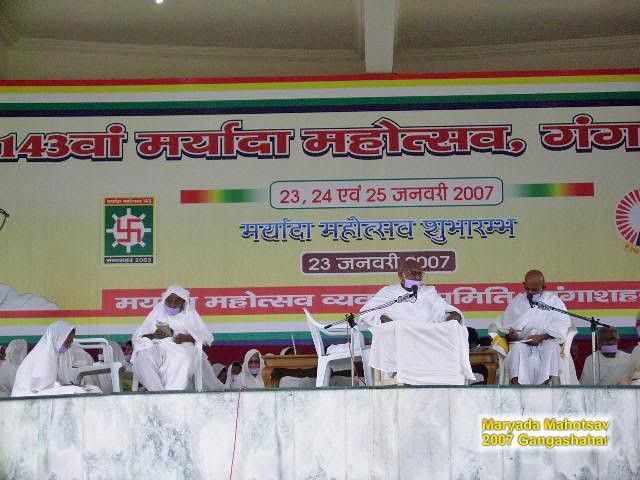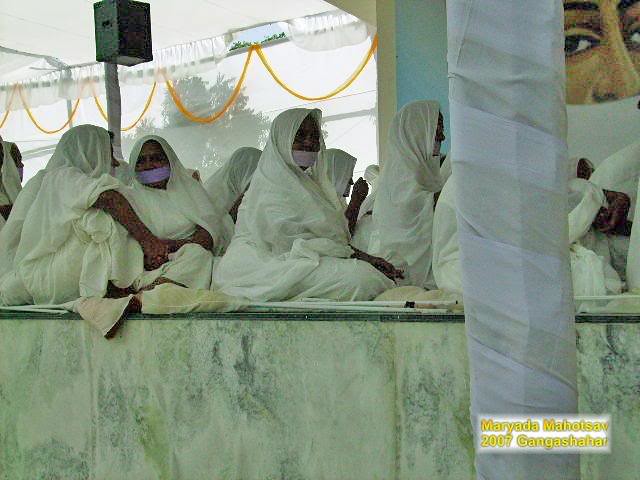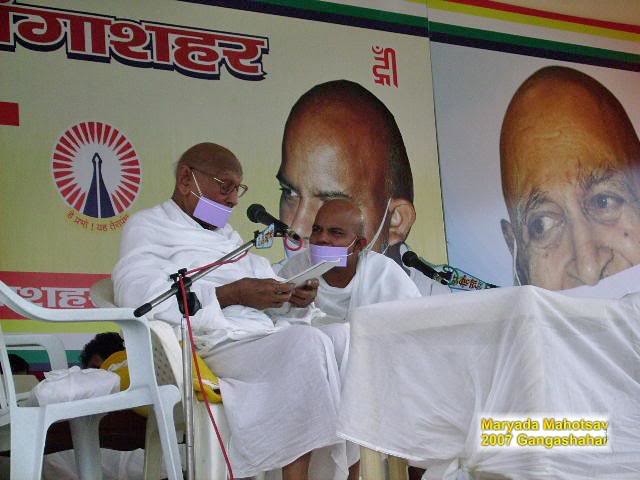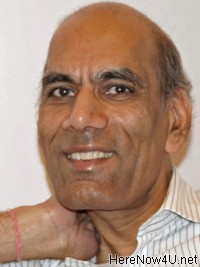After placement Maryada Patra at designated place by Acharyashri and after chorus singing of Maryada Geet led by Munishri Dineshkumarji, two munishris sang a geetika meaning “we will honor and respect every single letter written in Maryada patra; this is our determination and vow”. A request was then made and accordingly Acharyashri announced formal commencement of 3 day long 143rd Maryada Mahotsav festivities.
 Stage is all set for formal commencement of 243rd Maryada Mahotsav. Yuvacharyashri making final list of sadhu/sadhvis for serving in sewa kendras (23rd Jan 2007)
Stage is all set for formal commencement of 243rd Maryada Mahotsav. Yuvacharyashri making final list of sadhu/sadhvis for serving in sewa kendras (23rd Jan 2007)His Holiness said, “I pay obeisance hundreds and hundreds of times to farsightedness of Acharya Bhikshu.”


Acharyashri continued, “Because of his farsightedness only, today terapanth sangh is so strong and disciplined. Maryada (self discipline) is necessary for all units - family, society, dharm sangh etc. The work done by Acharya Bhikshu was really exceptional.” Taking the audience back to history, Acharyashri said, Acharya Bhikshu wrote first Maryada Patra in VS 1832 (around 1775 AD). After some revised Maryada Patras, the final version (8th Maryada patra) was written on Magh Sudi 7 VS 1859 - the day which is presently celebrated as Maryada Mahotsav Day. Acharyashri said, great men are rich with their great knowledge. Acharya Bhikshu possessed sharp intelligence. To tread the path shown by Acharya Bhikshu gives us great joy. This Maryada patra is our most valuable asset. It is desired that each member of four fold order alertly follows the rules laid down. The road to progress and development will then become easy. With this allegiance and confirmation, let us begin the festivities of Maryada Mahotsav”.
On behalf of Acharya Tusli Samadhi Sthal, Shri Ashkaranji Parakh made a welcome speech. Then ladies of Gangasahar Mahila Mandal sang a group song with wordings “This festival of discipline is a gift given to us by Shri Jayachraya, we pay obeisance to Acharya Bhiskhu”.
The program then shifted toward today’s main theme - SEWA (service for aged/ ill monks and nuns). Dear Readers, terapanth is the only jain sect where all monks and nuns follow guidance, discipline and orders of a single Acharya and do not make their personal disciples. In fact, this is the first sentence of Maryada Patra written by Acharya Bhikshu. While this condition brings out unparalleled growth, it also puts great responsibility on the shoulders of Acharya. To be taken care of in old age / in sickness etc is easily one reason for monks to make their individual disciples. But in terapanth, the acharyas have devised the mechanism of sewa, which takes care of this problem. Several SEWA KENDRAs (Service Centres) have been established where ill and old aged monks / nuns who are unable to walk long distances stay permanently. First such Sewa Kendra for nuns was established in Ladnun by Shri Jayacharya in VS 1914. Presently, there are total 8 sewa kendras (5 for nuns and 3 for monks). For all monks and nuns, it is compulsory to give sewa for a total of minimum three years. If it becomes necessary to do, they can be asked to give sewa for longer periods. There are no exceptions. Even Sadhvi Pramukhashri gave sewa. In a way, this is a very logical arrangement. When the monks and nuns are in young age and in good health, they give sewa. In turn, they are assured of getting sewa whenever they need it.

Appointments of sadhu/sadhvis to serve in sew Kendra is a standard first agenda item of Maryada Mahotsav program. This simply shows the seriousness with which terapanthi Acharya discharges his responsibility towards the ill/aged sadhu/sadhvis. All sadhu/sadhvis present at Mahotsav humbly offer to do sewa and make formal request for appointment as sewa provider in sewa kendra.
 Some sadhvishris sitting on stage (23rd Jan 2007)
Some sadhvishris sitting on stage (23rd Jan 2007)Sadhvishri Kanakshriji rose on behalf of all sadhvishris and made the request in heart touching words. She said “A person - as an individual generally has limited value. His value is enhanced when that person becomes part of society. In society, people are co-dependant on each other.” She termed sewa as a huge book which even a blind could read, sewa as a huge audition which even a deaf can hear, sewa as wonderful words which even a mute can speak”. She said the sewa providers get heartfelt blessings of the monks and nuns they serve. Upon conclusion of her request, all sadhvishris rose on their feet and with the sound of Vande Guruvaram they offered their services.

Shashan Gaurav Munishri Tarachandji then rose on behalf of all munishris and made the request for appointment in sewa kendra. He talked about 12 aspects of nirjara (shedding of karma) and said vaiyavrata (sewa) was one of those 12. He added that rest of 12 can be done/accomplished individually but for vaiyavrata (sewa) at least two are required - one who gives sewa and the other one who accepts sewa. Consequently, by staying in the dharm sangh only one can get a chance of sewa. Munishri gave the example of Munishri Khetsiji’s sewa to Acharya Bhikshu. He said, old age could still be far away; may be a person is not suffering from illness also - but people start worrying about old age and illness etc well in advance. In a wonderful setup like sewa as structured in terapanth sangh, all can become worry free.

Upon conclusion of his request, all munishris rose on their feet and with the sound of Vande Guruvaram they offered their services.
 Appointments for seva kendra personally announced by Acharyapravar - while Yuvacharyashri eagerly looked on!!! (23rd Jan 2007)
Appointments for seva kendra personally announced by Acharyapravar - while Yuvacharyashri eagerly looked on!!! (23rd Jan 2007) Acharyashri then him self made announcement of names for providing sewa as under (and Yuvacharyshri eagerly looked on!!!)
| Sewa Kendra | Name |
| Ladnun | Sadhvishri Kanchanprabhaji |
| Bidasar | Sadhvishri Kundanrekhaji |
| Gangasahar | Sadhvishri Somlataji |
| Shri Dungargarh | Sadhvishri Madhusmitaji |
| Rajaldesar | Sadhvishri Ratanshriji (Sri Dungargarh) |
| Chhapar | Muni Shri Sukhlalji / Munishri Mohjeetkumarji |
| Ladnun – JVB | Munishri Tarachandji |
| Sujangarh | Muni Shri Rajkaranji |
As and when the names were announced by Acharyashri, the named sadhu/sadhvi rose and bowed in vandana mudra as acceptance of the appointment.
 Sadhviji & Samaniji - intently listening to Acharyapravar (23rd Jan 2007)
Sadhviji & Samaniji - intently listening to Acharyapravar (23rd Jan 2007) Dear Readers, everyone intently listened these announcements. The program then continued. I will cover those details in my next post. In the meantime let me wish you a very wonderful weekend and
HAPPY HOLI
 R.K. Bengani
R.K. Bengani